Counting them out….
Elizabeth Blackwell was the world’s first trained and registered woman doctor. This would in itself be a remarkable achievement, but when you add in the fact that she lost the sight of one eye in the early stages of her training (treating a baby infected with an infectious form of ophthalmia), and that she had to move between the US, England and France to attain her goal, it puts her into an altogether different league.
I’ve been reading her story in Margaret Foster’s enthralling account of eight early pioneers of feminism, Significant Sisters. One 0f the clever things about the book is the way Forster tells the individual stories as a sequence, each marking some step forward but not necessarily all in a line. The ‘sisters’ had very different attitudes to progress for women.
Women’s health was generally pretty poor. As Forster says, working-class women were worked brutally hard, whilst middle-class women were rendered largely indolent but also had to carry 15-20lbs of material attached to a savagely corseted midriff. For these squashed and freighted women, boredom and inactivity combined to produce supposedly ‘hysterical’ behaviour. One consequence was some barbaric medical treatments. Look away now if you are a tad squeamish and don’t want to know where the title of this blog comes from……Leeches were used internally to cure women of problems following gynaecological surgery – and doctors were supposed to count them all in and out to make sure that none were left inside.
Three items from the Blackwell story hook in to the Paula Principle. First, the path to training and then to employment was a long one with obstacles thrown up at every point. Blackwell cunningly used disingenuous or hypocritical rejection letters sent by deans of the first medical schools she applied to in order to gain acceptance elsewhere. So she wrote to Castleton Medical School saying that “Dr Jackson of the University of Philadelphia and Dr Mitchell of Jefferson Medical College expressed regret that the size and character of their classes would prevent me from becoming a member of them but declared their hearty approval of my endeavour and both advised me to seek aid from your institution…” She got it, but it became ever clearer that progress was not a matter of logic about competence; once Elizabeth had won one argument over her admission, the men in charge of the profession would find another obstacle to put in her way.
Secondly, qualifying as doctor was much more than a start, but it certainly was not the end of the story. There were then all sorts of complications in finding somewhere where she could set up to practice, and in employing other women as nurses , and then as doctors. The PP implication is simply this: Qualification does not bring with it the opportunity to put one’s skills to use.
The third point is about the pace of change. I was surprised to find out about Blackwell, and how early she is as the first woman doctor, graduating in 1849. Writing well over a century later, in 1984, Forster points out how women are still very much in a minority in UK medical schools, and make up only 11% of consultants. But just 30 years on and women are now very much the majority in medical schools. I don’t have to hand the figure on their share in consultant posts, but it would be interesting to take bets on when it will pass, say, 40%.
These individual stories fill me with admiration for the incredible determination of the women. They also give us a range of perspectives on progress or its absence.

